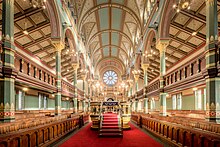The examples and perspective in this article may not represent a worldwide view of the subject. (September 2019) |

Sacral architecture (also known as sacred architecture or religious architecture) is a religious architectural practice concerned with the design and construction of places of worship or sacred or intentional space, such as churches, mosques, stupas, synagogues, and temples. Many cultures devoted considerable resources to their sacred architecture and places of worship. Religious and sacred spaces are amongst the most impressive and permanent monolithic buildings created by humanity. Conversely, sacred architecture as a locale for meta-intimacy may also be non-monolithic, ephemeral and intensely private, personal and non-public.

Sacred, religious and holy structures often evolved over centuries and were the largest buildings in the world, prior to the modern skyscraper.[citation needed] While the various styles employed in sacred architecture sometimes reflected trends in other structures, these styles also remained unique from the contemporary architecture used in other structures. With the rise of Christianity and Islam, religious buildings increasingly became centres of worship, prayer and meditation.[citation needed]

The Western scholarly discipline of the history of architecture itself closely follows the history of religious architecture from ancient times until the Baroque period, at least. Sacred geometry, iconography, and the use of sophisticated semiotics such as signs, symbols and religious motifs are endemic to sacred architecture.